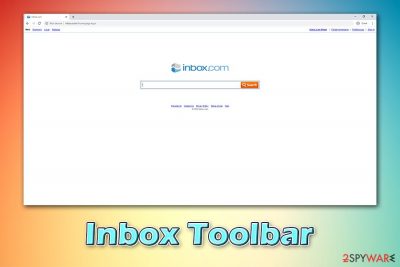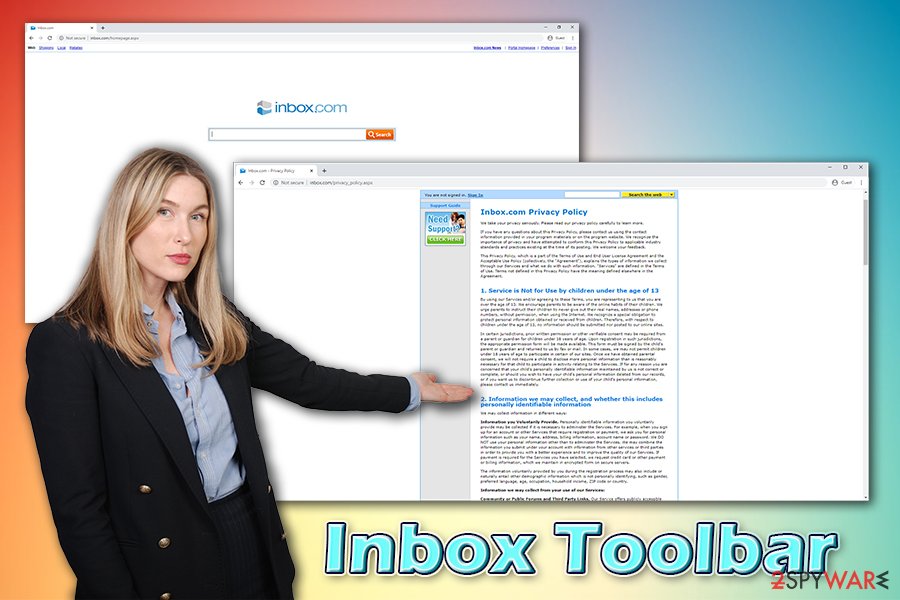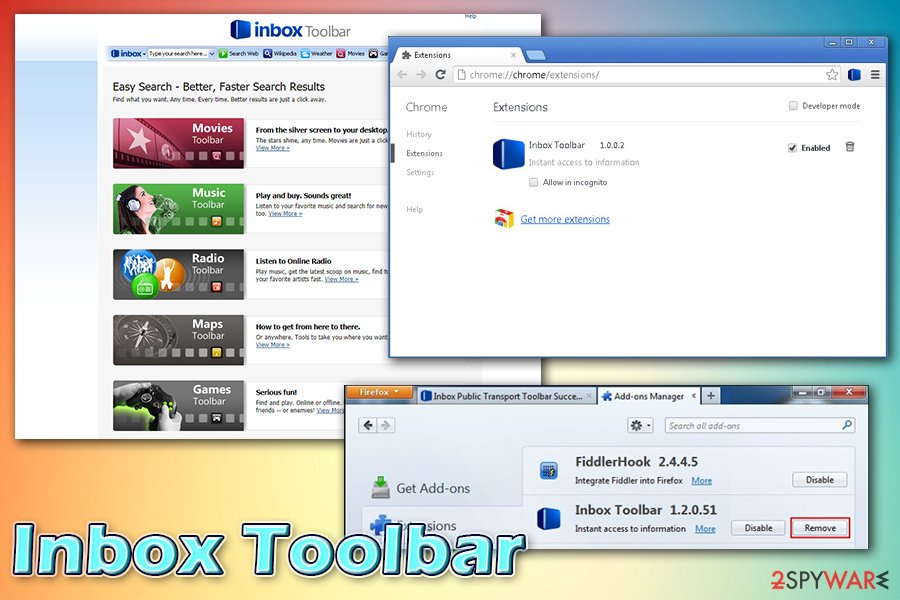Inbox Toolbar (Removal Instructions) - updated Mar 2020
Inbox Toolbar Removal Guide
What is Inbox Toolbar?
Inbox Toolbar is unnecessary browser plugin that will show you intrusive ads

Inbox Toolbar is yet another suspicious application that was known for its browser-hijacking[1] capabilities on Google Chrome, Mozilla Firefox, or MS Edge web browsers. The app may infiltrate your computer behind your back because it has been actively promoted with the help of bundling – an unfair marketing campaign that deliberately hides optional components from users' sight during the installation process of the program.
Similarly to other hijackers, Inbox Toolbar changes the settings of the web browser and appends Inbox Toolbar. From that point, users are presented with a customized search engine that populates the browser with sponsored search results at the top, increasing the chances of people clicking on ads instead of organic results. Additionally, Inbox Toolbar is also set to track users' web browsing activities and even their location, if a mobile device is used. While the app was discontinued, it can still be downloaded from various places on the internet by accident, so we highly advise you to remove Inbox Toolbar if you have it installed.
| Name | Inbox Toolbar |
|---|---|
| Type | Browser hijacker, potentially unwanted program |
| Infiltration | Potentially unwanted applications are typically delivered via software bundle packages or are downloaded intentionally via third-party websites |
| Symptoms |
|
| Dangers | Installation of other potentially unwanted programs or malware, personal information disclosure to unknown parties/cybercriminals, monetary loss due to scams or phishing messages, etc. |
| Termination | You cab get rid of the unwanted app by following our manual removal instructions listed below or use automatic anti-malware tools |
| System fix | If you are struggling with various errors and crashes, we strongly advise you use FortectIntego to fix these issues on your PC |
Developers of the Inbox Toolbar virus present the app as a useful addition to every users' web browser and claim that it will enhance the web browsing routine of anyone using it. The app is described as follows:
Easy Search – Better, Faster Search Results
Find what you want. Any time. Every time. Better results are just a click away.
The official website used to include a variety of other different applications that the developers used to distribute, including Movies Toolbar, Music Toolbar, Maps toolbar, Games toolbar, and so on. Each of these would be used for different purposes and seemingly help users find what they are looking for faster, and more efficiently.
While it might sound promising, it is important to note that poor quality search tools like Inbox Toolbar rarely benefit users, and the main goal of the app is exposing them to all sorts of ads, including pop-ups, in-text links, auto-play, flashing windows, banners, coupons, and others.
Allegedly, Inbox Toolbar should be a helpful tool for people who are looking for some sort of information on the internet. However, it may show you altered search results that may try to redirect you to its affiliate websites. If you want to avoid Inbox redirects to unknown places, you should avoid this program.
It is important to note that those infected with Inbox Toolbar will have their web browsers set to hxxp://www.inbox.com/homepage.aspx, which also includes a customized search engine. As mentioned above, this allows the hijacker to display sponsored content to users. In some cases, unfortunately, you may end up on insecure websites that are filled with scam messages or malware.

For example, if you access a hacked or otherwise compromised website, a drive-by download[2] would initiate the infection automatically (this works with the help of software vulnerabilities[3] and lack of installed anti-malware software, so it is important to ensure that these security holes are patched). Therefore, while Inbox Toolbar is not considered to be malware, its presence might be the reason for it being installed sometime later.
Besides, Inbox Toolbar is set to track a variety of information about users' online activity. While no personal data is shared with other parties, anonymous information like:
- IP address, (note that the IP is considered to be PII in some US states and other countries)
- visited sites,
- search terms,
- links clicked, and other data.
Additionally, if you are using the Inbox Toolbar on your phone, it may lead to the disclosure of your current location via the GPS. Here's the explanation of how this can happen:
Some photos and videos you place in or on our Services may contain recorded location information. We may use this information to optimize your experience. If you do not wish to share files embedded with your geo-location information with us, please do not upload them. If you don’t want to store location data in your photos or videos, please consult the documentation for your camera, phone or other device to turn off that feature.
Most of people do not change the default settings of their apps, so they end up sharing their location without knowing if Inbox Toolbar is installed.
Due to all these listed reasons, we highly advise you proceed with Inbox Toolbar removal from your device as soon as possible. There is no need to share your data with unknown third-parties, have your browsers being spammed with ads, and risk of infecting your computer with malware. Get rid of the PUP either manually or automatically as explained below and then reset the installed browsers. In case you noticed slowdowns or other unwanted side-effects after eliminating Inbox Toolbar, scan your system with FortectIntego.
PUPs are often hidden inside the software bundle installers
Beware that you can easily download this and other toolbars from their official websites or in a bundle with other apps. This distribution technique is called bundling, so the main thing that you need to keep in mind when installing download managers, PDF creators, video streaming software and similar apps is that you have to be very very careful during their installation.
The most common way how Inbox Toolbar virus may infiltrate your system is when downloading and installing freewares without checking their installation process. Of course, you can also download this program directly from its official website but in most of the cases toolbars are bundled with third-party programs that seek to earn some easy money. That's why you should be very cautious when downloading and installing questionable programs from the web.
By selecting advanced or similar installation method, you will be able to track every installation step and prevent their infiltration. Don't forget to unmark any additional plug-ins and/or extensions that you are not familiar with. If you noticed that toolbar.inbox.com hijacked your browsers, you should waste no time and check the system for this web browser plug-in.

Remove Inbox Toolbar from your system and use official search tools instead
In order to avoid further problems, we recommend you to remove Inbox Toolbar from the system. There are plenty of legitimate search engines available to choose from – the most commonly used Google.com. If you want more privacy, you can also switch to privacy-focused search engines/browsers, e.g., DuckDuckGo or Brave Browser.
For a comprehensive Inbox Toolbar removal, we recommend scanning the device with anti-malware software. Nevertheless, be aware that not all security programs will recognize it as threat, so if you have no luck with it, you can terminate Inbox Toolbar virus with the help of our instructions below.
Regardless of which removal method you choose, we recommend resetting the installed web browsers to ensure that the unwanted activity by Inbox Toolbar returns in the future – you can find the instructions on how to do that below.
You may remove virus damage with a help of FortectIntego. SpyHunter 5Combo Cleaner and Malwarebytes are recommended to detect potentially unwanted programs and viruses with all their files and registry entries that are related to them.
Getting rid of Inbox Toolbar. Follow these steps
Uninstall from Windows
To get rid of PUPs from Windows, access Control Panel/Programs & features section as explained below:
Instructions for Windows 10/8 machines:
- Enter Control Panel into Windows search box and hit Enter or click on the search result.
- Under Programs, select Uninstall a program.

- From the list, find the entry of the suspicious program.
- Right-click on the application and select Uninstall.
- If User Account Control shows up, click Yes.
- Wait till uninstallation process is complete and click OK.

If you are Windows 7/XP user, proceed with the following instructions:
- Click on Windows Start > Control Panel located on the right pane (if you are Windows XP user, click on Add/Remove Programs).
- In Control Panel, select Programs > Uninstall a program.

- Pick the unwanted application by clicking on it once.
- At the top, click Uninstall/Change.
- In the confirmation prompt, pick Yes.
- Click OK once the removal process is finished.
Delete from macOS
macOS users should perform the following steps in order to remove Inbox Toolbar from their computers:
Remove items from Applications folder:
- From the menu bar, select Go > Applications.
- In the Applications folder, look for all related entries.
- Click on the app and drag it to Trash (or right-click and pick Move to Trash)

To fully remove an unwanted app, you need to access Application Support, LaunchAgents, and LaunchDaemons folders and delete relevant files:
- Select Go > Go to Folder.
- Enter /Library/Application Support and click Go or press Enter.
- In the Application Support folder, look for any dubious entries and then delete them.
- Now enter /Library/LaunchAgents and /Library/LaunchDaemons folders the same way and terminate all the related .plist files.

Remove from Microsoft Edge
Delete unwanted extensions from MS Edge:
- Select Menu (three horizontal dots at the top-right of the browser window) and pick Extensions.
- From the list, pick the extension and click on the Gear icon.
- Click on Uninstall at the bottom.

Clear cookies and other browser data:
- Click on the Menu (three horizontal dots at the top-right of the browser window) and select Privacy & security.
- Under Clear browsing data, pick Choose what to clear.
- Select everything (apart from passwords, although you might want to include Media licenses as well, if applicable) and click on Clear.

Restore new tab and homepage settings:
- Click the menu icon and choose Settings.
- Then find On startup section.
- Click Disable if you found any suspicious domain.
Reset MS Edge if the above steps did not work:
- Press on Ctrl + Shift + Esc to open Task Manager.
- Click on More details arrow at the bottom of the window.
- Select Details tab.
- Now scroll down and locate every entry with Microsoft Edge name in it. Right-click on each of them and select End Task to stop MS Edge from running.

If this solution failed to help you, you need to use an advanced Edge reset method. Note that you need to backup your data before proceeding.
- Find the following folder on your computer: C:\\Users\\%username%\\AppData\\Local\\Packages\\Microsoft.MicrosoftEdge_8wekyb3d8bbwe.
- Press Ctrl + A on your keyboard to select all folders.
- Right-click on them and pick Delete

- Now right-click on the Start button and pick Windows PowerShell (Admin).
- When the new window opens, copy and paste the following command, and then press Enter:
Get-AppXPackage -AllUsers -Name Microsoft.MicrosoftEdge | Foreach {Add-AppxPackage -DisableDevelopmentMode -Register “$($_.InstallLocation)\\AppXManifest.xml” -Verbose

Instructions for Chromium-based Edge
Delete extensions from MS Edge (Chromium):
- Open Edge and click select Settings > Extensions.
- Delete unwanted extensions by clicking Remove.

Clear cache and site data:
- Click on Menu and go to Settings.
- Select Privacy, search and services.
- Under Clear browsing data, pick Choose what to clear.
- Under Time range, pick All time.
- Select Clear now.

Reset Chromium-based MS Edge:
- Click on Menu and select Settings.
- On the left side, pick Reset settings.
- Select Restore settings to their default values.
- Confirm with Reset.

Remove from Mozilla Firefox (FF)
Remove dangerous extensions:
- Open Mozilla Firefox browser and click on the Menu (three horizontal lines at the top-right of the window).
- Select Add-ons.
- In here, select unwanted plugin and click Remove.

Reset the homepage:
- Click three horizontal lines at the top right corner to open the menu.
- Choose Options.
- Under Home options, enter your preferred site that will open every time you newly open the Mozilla Firefox.
Clear cookies and site data:
- Click Menu and pick Settings.
- Go to Privacy & Security section.
- Scroll down to locate Cookies and Site Data.
- Click on Clear Data…
- Select Cookies and Site Data, as well as Cached Web Content and press Clear.

Reset Mozilla Firefox
If clearing the browser as explained above did not help, reset Mozilla Firefox:
- Open Mozilla Firefox browser and click the Menu.
- Go to Help and then choose Troubleshooting Information.

- Under Give Firefox a tune up section, click on Refresh Firefox…
- Once the pop-up shows up, confirm the action by pressing on Refresh Firefox.

Remove from Google Chrome
Reset Google Chrome as soon as you eliminate the PUP:
Delete malicious extensions from Google Chrome:
- Open Google Chrome, click on the Menu (three vertical dots at the top-right corner) and select More tools > Extensions.
- In the newly opened window, you will see all the installed extensions. Uninstall all the suspicious plugins that might be related to the unwanted program by clicking Remove.

Clear cache and web data from Chrome:
- Click on Menu and pick Settings.
- Under Privacy and security, select Clear browsing data.
- Select Browsing history, Cookies and other site data, as well as Cached images and files.
- Click Clear data.

Change your homepage:
- Click menu and choose Settings.
- Look for a suspicious site in the On startup section.
- Click on Open a specific or set of pages and click on three dots to find the Remove option.
Reset Google Chrome:
If the previous methods did not help you, reset Google Chrome to eliminate all the unwanted components:
- Click on Menu and select Settings.
- In the Settings, scroll down and click Advanced.
- Scroll down and locate Reset and clean up section.
- Now click Restore settings to their original defaults.
- Confirm with Reset settings.

Delete from Safari
Remove unwanted extensions from Safari:
- Click Safari > Preferences…
- In the new window, pick Extensions.
- Select the unwanted extension and select Uninstall.

Clear cookies and other website data from Safari:
- Click Safari > Clear History…
- From the drop-down menu under Clear, pick all history.
- Confirm with Clear History.

Reset Safari if the above-mentioned steps did not help you:
- Click Safari > Preferences…
- Go to Advanced tab.
- Tick the Show Develop menu in menu bar.
- From the menu bar, click Develop, and then select Empty Caches.

After uninstalling this potentially unwanted program (PUP) and fixing each of your web browsers, we recommend you to scan your PC system with a reputable anti-spyware. This will help you to get rid of Inbox Toolbar registry traces and will also identify related parasites or possible malware infections on your computer. For that you can use our top-rated malware remover: FortectIntego, SpyHunter 5Combo Cleaner or Malwarebytes.
How to prevent from getting browser hijacker
Stream videos without limitations, no matter where you are
There are multiple parties that could find out almost anything about you by checking your online activity. While this is highly unlikely, advertisers and tech companies are constantly tracking you online. The first step to privacy should be a secure browser that focuses on tracker reduction to a minimum.
Even if you employ a secure browser, you will not be able to access websites that are restricted due to local government laws or other reasons. In other words, you may not be able to stream Disney+ or US-based Netflix in some countries. To bypass these restrictions, you can employ a powerful Private Internet Access VPN, which provides dedicated servers for torrenting and streaming, not slowing you down in the process.
Data backups are important – recover your lost files
Ransomware is one of the biggest threats to personal data. Once it is executed on a machine, it launches a sophisticated encryption algorithm that locks all your files, although it does not destroy them. The most common misconception is that anti-malware software can return files to their previous states. This is not true, however, and data remains locked after the malicious payload is deleted.
While regular data backups are the only secure method to recover your files after a ransomware attack, tools such as Data Recovery Pro can also be effective and restore at least some of your lost data.
- ^ Browser Hijacking. PixelPrivacy. All about online privacy.
- ^ How malware works: Anatomy of a drive-by download web attack (Infographic). Sophos. Security blog.
- ^ Vulnerability (computing). Wikipedia. The free encyclopedia.























